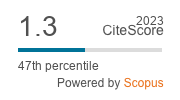Economic Drivers of Consumer Price Growth in the EU–27 Service Industry during the Post‑pandemic Period
DOI:
https://doi.org/10.18778/1508-2008.26.36Keywords:
economics, inflation, consumer prices, servicesAbstract
The post‑pandemic period in the European Union is distinguished by the growth of business economic activity after two years of restrictions, growing debts and money supply, and extremely high inflation. This research analyses the Harmonised Index of Consumer Prices (HICP) in the service industries of the EU–27, comparing it to overall inflation and price growth in consumer goods markets. It also highlights the economic factors that contribute to the differences between service price growth in the EU–27. The results make it possible to classify the EU–27 countries according to the differences in service price changes. Consistent patterns of service HICP are highlighted, and the economic factors considering their relative importance to service HICP are ranked. Since 2022, public and governmental discussions concerning the post‑pandemic inflationary shock have become prevalent, so this research allows us to understand the economic factors that caused such huge inflation and substantiates the need for monetary policy measures to slow down inflation.
Downloads
References
Altunbaş, Y., Thornton, J. (2022), Does inflation targeting increase income inequality?, “Journal of Post Keynesian Economics”, 45 (4), pp. 558–580, https://doi.org/10.1080/01603477.2022.2101475
Google Scholar
DOI: https://doi.org/10.1080/01603477.2022.2101475
Amirul, S.R., Pazim, K.H., Amirul, S.M., Mail, R., Dasan, J. (2022), Developing and validating the qualitative labour productivity measurement in service industry, “Quality & Quantity”, 56, pp. 2853–2874, https://doi.org/10.1007/s11135-021-01220-9
Google Scholar
DOI: https://doi.org/10.1007/s11135-021-01220-9
Batayneh, K., Salamat, W.A., Momani, M.Q.M. (2021), The impact of inflation on the financial sector development: Empirical evidence from Jordan, “Cogent Economics & Finance”, 9 (1), pp. 1–15, https://doi.org/10.1080/23322039.2021.1970869
Google Scholar
DOI: https://doi.org/10.1080/23322039.2021.1970869
Boaretto, G.O., Da Silva, C.G. (2019), Services inflation dynamics and persistence puzzle in Brazil: A time‑varying parameter approach, “Applied Economics”, 51 (13), pp. 1450–1462, https://doi.org/10.1080/00036846.2018.1527456
Google Scholar
DOI: https://doi.org/10.1080/00036846.2018.1527456
Bresser‑Pereira, L.C. (2020), Financing COVID–19, inflation and the fiscal constraint, “Forum for Social Economics”, 49 (3), pp. 241–256, https://doi.org/10.1080/07360932.2020.1792176
Google Scholar
DOI: https://doi.org/10.1080/07360932.2020.1792176
Central banks – summary of current interest rates (n.d.), https://www.global‑rates.com/en/interest‑rates/central‑banks/central‑banks.aspx (accessed: 28.01.2023).
Google Scholar
Charalampidis, N., Guillochon, J. (2022), The COVID–19 pandemic and the consumption of nondurables and services, “Applied Economics Letters”, 29 (12), pp. 1084–1095, https://doi.org/10.1080/13504851.2021.1908515
Google Scholar
DOI: https://doi.org/10.1080/13504851.2021.1908515
Conflitti, C., Zizza, R. (2021), What’s behind firms’ inflation forecasts?, “Empirical Economics”, 61, pp. 2449–2475, https://doi.org/10.1007/s00181-020-01958-5
Google Scholar
DOI: https://doi.org/10.1007/s00181-020-01958-5
Estrada, M.A.R. (2021), How much unemployment and inflation is going to be generated by COVID–19?, “Transnational Corporations Review”, 13 (2), pp. 202–210, https://doi.org/10.1080/19186444.2021.1912991
Google Scholar
DOI: https://doi.org/10.1080/19186444.2021.1912991
European Cenral Bank (n.d.), Key ECB interest rates, https://www.ecb.europa.eu/stats/policy_and_exchange_rates/key_ecb_interest_rates/html/index.en.html (accessed: 28.01.2023).
Google Scholar
Eurostat (2022a), Annual enterprise statistics for special aggregates of activities (NACE Rev. 2), https://ec.europa.eu/eurostat/databrowser/view/SBS_NA_SCA_R2__custom_7564372/default/table?lang=en (accessed: 18.01.2023).
Google Scholar
Eurostat (2022b), Database, https://ec.europa.eu/eurostat/web/main/data/database (accessed: 14.01.2023).
Google Scholar
Eurostat (2022c), GDP and main components (output, expenditure and income), https://ec.europa.eu/eurostat/databrowser/view/NAMQ_10_GDP__custom_6235904/default/table?lang=en (accessed: 27.01.2023).
Google Scholar
Eurostat (2022d), Government deficit/surplus, debt and associated data, https://ec.europa.eu/eurostat/databrowser/view/GOV_10DD_EDPT1__custom_6237194/default/table?lang=en (accessed: 22.01.2023).
Google Scholar
Eurostat (2022e), HICP – monthly data (index), https://ec.europa.eu/eurostat/databrowser/view/PRC_HICP_MIDX/default/table?lang=en (accessed: 22.01.2023).
Google Scholar
Eurostat (2022f), International trade in services (since 2010) (BPM6), https://ec.europa.eu/eurostat/databrowser/view/BOP_ITS6_DET/default/table?lang=en (accessed: 22.01.2023).
Google Scholar
Eurostat (2022g), Labour input in services – monthly data, and Eurostat 2022, Production in services – monthly data, https://ec.europa.eu/eurostat/databrowser/view/STS_SELB_M__custom_6236651/default/table?lang=en (accessed: 27.01.2023).
Google Scholar
Eurostat (2022h), Net electricity generation by type of fuel – monthly data, https://ec.europa.eu/eurostat/databrowser/view/NRG_CB_PEM__custom_6236182/default/table?lang=en (accessed: 2.02.2023).
Google Scholar
Eurostat (2022i), Private sector credit flow: loans by sectors, consolidated – million units of national currency, https://ec.europa.eu/eurostat/databrowser/view/tipspc26/default/table?lang=en(accessed: 2.02.2023).
Google Scholar
Eurostat (2022j), Production in services – monthly data, https://ec.europa.eu/eurostat/databrowser/view/STS_SELB_M__custom_6236651/default/table?lang=en (accessed: 2.02.2023).
Google Scholar
Eurostat (2022k), Supply electricity – short term monthly data, https://ec.europa.eu/eurostat/databrowser/view/NRG_IND_342M__custom_6236473/default/table?lang=en (accessed: 2.02.2023).
Google Scholar
Eurostat (2022l), Turnover in services – quarterly data, https://ec.europa.eu/eurostat/databrowser/view/STS_SETU_Q/default/table?lang=en (accessed: 2.02.2023).
Google Scholar
Gong, D., Qian, Z. (2022), Inflation targeting and financial crisis, “Applied Economics”, 54 (41), pp. 4782–4795, https://doi.org/10.1080/00036846.2022.2036685
Google Scholar
DOI: https://doi.org/10.1080/00036846.2022.2036685
Ho, T., Nguyen, V.B., Nguyen, T.B.N. (2021), The different role of governance in the fiscal deficit – inflation between developed and developing countries, “Macroeconomics and Finance in Emerging Market Economies”, pp. 1–12, https://doi.org/10.1080/17520843.2021.1973787
Google Scholar
DOI: https://doi.org/10.1080/17520843.2021.1973787
Kim, H. (2022), Minsky’s theory of inflation and its theoretical and empirical relevance to credit‑driven economies, “Journal of Economic Issues”, 56 (1), pp. 79–96, https://doi.org/10.1080/00213624.2022.2009261
Google Scholar
DOI: https://doi.org/10.1080/00213624.2022.2009261
Lapavitsas, C. (2022), The return of inflation and the weakness of the side of production, “The Japanese Political Economy”, 48 (2–4), pp. 149–169, https://doi.org/10.1080/2329194X.2022.2142613
Google Scholar
DOI: https://doi.org/10.1080/2329194X.2022.2142613
Lieb, L., Schuffels, J. (2022), Inflation expectations and consumer spending: the role of household balance sheets, “Empirical Economics”, 63, pp. 2479–2512, https://doi.org/10.1007/s00181-022-02222-8
Google Scholar
DOI: https://doi.org/10.1007/s00181-022-02222-8
Nickel, C., Koester, G., Lis, E. (2022), Inflation Developments in the Euro Area Since the Onset of the Pandemic, “Intereconomics”, 57 (2), pp. 69–75, https://doi.org/10.1007/s10272-022-1032‑y
Google Scholar
DOI: https://doi.org/10.1007/s10272-022-1032-y
Sisay, E., Atilaw, W., Adisu, T. (2022), Impact of economic sectors on inflation rate: Evidence from Ethiopia, “Cogent Economics & Finance”, 10 (1), pp. 1–24, https://doi.org/10.1080/23322039.2022.2123889
Google Scholar
DOI: https://doi.org/10.1080/23322039.2022.2123889
Skare, M., Soriano, D.R. (2022), Explaining COVID–19 shock wave mechanism in the European service industry using convergence clubs analysis, “Service Business”, 16, pp. 283–307, https://doi.org/10.1007/s11628-021-00471-8
Google Scholar
DOI: https://doi.org/10.1007/s11628-021-00471-8
Stukalo, N., Simakhova, A., Baltgailis, J. (2022), The COVID–19 Pandemic’s Impact on the Social Economy in European Countries, “Comparative Economic Research. Central and Eastern Europe”, 25 (1), pp. 109–125, https://doi.org/10.18778/1508-2008.25.07
Google Scholar
DOI: https://doi.org/10.18778/1508-2008.25.07
Ubide, A. (2022), The inflation Surge of 2021–22: Scarcity of Goods and Commodities, Strong Labor Markets and Anchored Inflation Expectations, “Intereconomics”, 57 (2), pp. 93–98, https://doi.org/10.1007/s10272-022-1036-7
Google Scholar
DOI: https://doi.org/10.1007/s10272-022-1036-7
Urquhart, M.D. (2022), Public debt, inflation, and the Fiscal Theory of Price Level in emerging markets: the case of Paraguay, “Macroeconomics and Finance in Emerging Market Economies”, 15 (3), pp. 246–272, https://doi.org/10.1080/17520843.2021.1927128
Google Scholar
DOI: https://doi.org/10.1080/17520843.2021.1927128
Downloads
Published
How to Cite
Issue
Section
License

This work is licensed under a Creative Commons Attribution-NonCommercial-NoDerivatives 4.0 International License.











